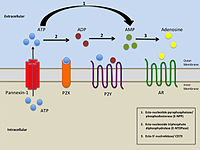
Photo from wikipedia
Abstract Context Emodin is a compound in Rheum undulatum Linne (Polygonaceae) that has been reported to exert anti-inflammatory, antibacterial, and antiallergic effects. Objective Oxidative stress is a causative agent of… Click to show full abstract
Abstract Context Emodin is a compound in Rheum undulatum Linne (Polygonaceae) that has been reported to exert anti-inflammatory, antibacterial, and antiallergic effects. Objective Oxidative stress is a causative agent of liver inflammation that may lead to fibrosis and hepato-carcinoma. In this study, we investigated the antioxidant effects of emodin and its mechanism. Materials and methods We used the hepatocyte stimulated by arachidonic acid (AA) + iron cotreatment and the C57B/6 mice orally injected with acetaminophen (APAP, 500 mg/kg, 6 h), as assessed by immunoblot and next generation sequencing (NGS). Emodin was pre-treated in hepatocyte (3 ∼ 30 μM) for 1 h before AA + iron, and in mice (10 and 30 m/kg, P.O.) for 3 days before APAP. Results In vitro, emodin treatment inhibited the cell death induced by AA + iron maximally at a dose of 10 μM (EC50 > 3 μM). In addition, emodin attenuated the decrease of anti-apoptotic proteins, and restored mitochondria membrane potential as mediated by the liver kinase B1 (LKB1)-AMP-activated protein kinase (AMPK) pathway. LKB1 mediated AMPK activation was verified using the LKB1 deficient cell line, HeLa. Emodin (10 μM; after 10 min) also induced the phosphorylation of Yes-associated protein 1 (YAP1), the main downstream target of the Hippo signalling pathway that mediated oxidative stress or the ROS-initiated signalling pathway. In vivo, the oral treatment of emodin (10 and 30 m/kg, 3 days) decreased APAP-induced hepatic damage, as indicated by decreases in antioxidant genes as well as tissue damage. Conclusion Our results show that emodin inhibits oxidative liver injury via the AMPK/YAP mediated pathway.
Journal Title: Pharmaceutical Biology
Year Published: 2020
Link to full text (if available)
Share on Social Media: Sign Up to like & get
recommendations!